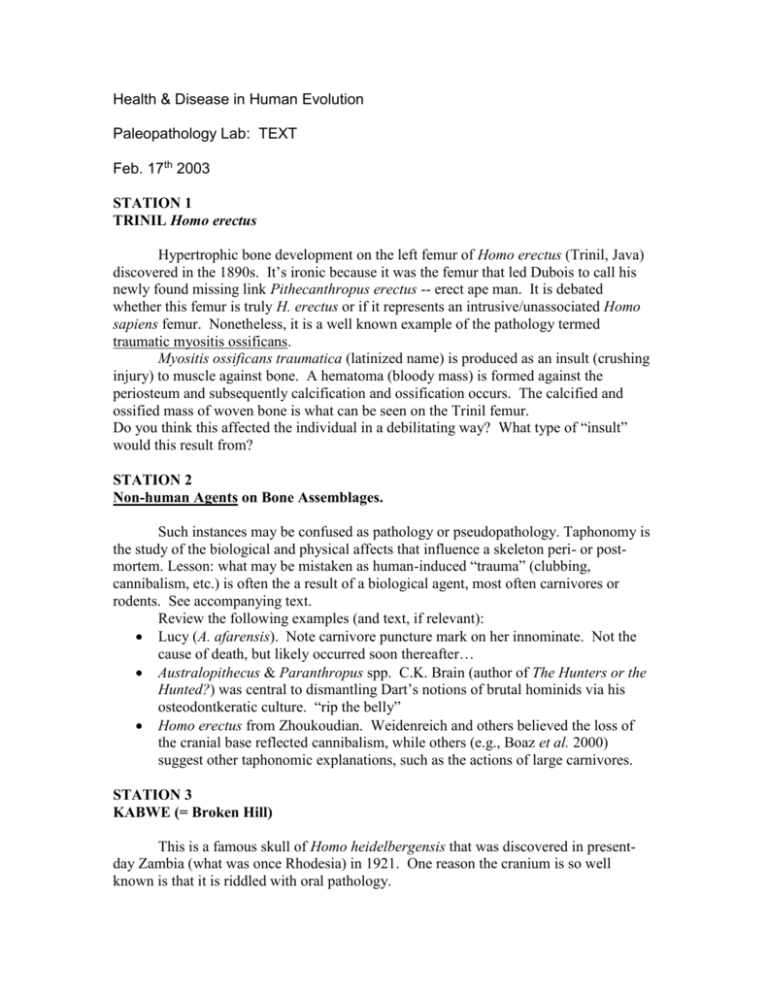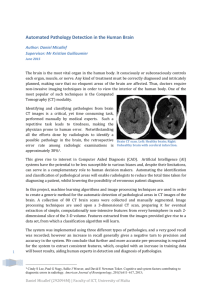4930_lab_3
advertisement

Health & Disease in Human Evolution Paleopathology Lab: TEXT Feb. 17th 2003 STATION 1 TRINIL Homo erectus Hypertrophic bone development on the left femur of Homo erectus (Trinil, Java) discovered in the 1890s. It’s ironic because it was the femur that led Dubois to call his newly found missing link Pithecanthropus erectus -- erect ape man. It is debated whether this femur is truly H. erectus or if it represents an intrusive/unassociated Homo sapiens femur. Nonetheless, it is a well known example of the pathology termed traumatic myositis ossificans. Myositis ossificans traumatica (latinized name) is produced as an insult (crushing injury) to muscle against bone. A hematoma (bloody mass) is formed against the periosteum and subsequently calcification and ossification occurs. The calcified and ossified mass of woven bone is what can be seen on the Trinil femur. Do you think this affected the individual in a debilitating way? What type of “insult” would this result from? STATION 2 Non-human Agents on Bone Assemblages. Such instances may be confused as pathology or pseudopathology. Taphonomy is the study of the biological and physical affects that influence a skeleton peri- or postmortem. Lesson: what may be mistaken as human-induced “trauma” (clubbing, cannibalism, etc.) is often the a result of a biological agent, most often carnivores or rodents. See accompanying text. Review the following examples (and text, if relevant): Lucy (A. afarensis). Note carnivore puncture mark on her innominate. Not the cause of death, but likely occurred soon thereafter… Australopithecus & Paranthropus spp. C.K. Brain (author of The Hunters or the Hunted?) was central to dismantling Dart’s notions of brutal hominids via his osteodontkeratic culture. “rip the belly” Homo erectus from Zhoukoudian. Weidenreich and others believed the loss of the cranial base reflected cannibalism, while others (e.g., Boaz et al. 2000) suggest other taphonomic explanations, such as the actions of large carnivores. STATION 3 KABWE (= Broken Hill) This is a famous skull of Homo heidelbergensis that was discovered in presentday Zambia (what was once Rhodesia) in 1921. One reason the cranium is so well known is that it is riddled with oral pathology. The etiology of these pathologies (mainly dental caries) has been debated – in your Reader, an article by Bartsiokas & Day (1993) suggest chronic lead poisoning and the action of anaerobic bacteria producing H2S. Another paper by Puech et al. (1980) suggests a change towards a more vegetarian diet. Check it out! Also check out the picture of dental abscess & calculus (mineralized plaque) deposits in Roberts & Manchester (1997:51). ID the teeth and record your observations for those (1) destroyed down to the root, (2) those with large carious lesions, and (3) those with small carious lesions. Use the format from Digging up Bones: STATION 4 Lucy (Australopithecus afarensis) – vertebral pathology This famous hominin was a pretty healthy adult individual, although she did suffer some wear and tear on her axial skeleton. Last lab (Station 2) you were introduced to arthropathies (joint diseases) and the osteophytes (bony outgrowths) that develop on worn and torn areas of the skeleton. Vertebral osteophytosis occurs due to degeneration of the intervertebral disks. This can cause new bone formation on various aspects of the vertebral body and joint facets. Kyphosis refers to abnormal curvature of the spine and is evident on T6-T10. Here “wedging” of the vertebral bodies is evident. Review the pictures and descriptions in the accompanying text (AJPA -- Cook et al. 1983:83-101). Observe Thoracic vertebrae 10 & 11 [-1ac & -1ad] and refer to Fig. 4 (p. 90). Articulate Thoracic vertebrae 6-8 [-1ae (=“AH”), -1af, -1ag] and refer to Fig. 5 (p. 91). What might be the purpose of the new bone formation observed by the authors on the ventral portions of the thoracic vertebral bodies? STATION 5 Cribra Orbitalia & Porotic Hyperostosis Diseases due to metabolic or dietary deficiencies or imbalances (e.g., iron deficiency anemia, scurvy, and rickets) affect bone biology and bone maintenance. With anemia, expansion of the diploë (bone marrow space between the cortical bone of the skull) due to increased red blood cell production is the root cause for the proliferation of osteoblast activity. Cribra orbitalia is the term for the condition occurring in the superior portion of eye orbits. Porotic (= spongy) hyperostosis is a more general term. Note the differences between “healed” vs. “active” on pp. 323 and 324 of the AJPA article. Link to pdf file. Also note the typical pattern on the back of the subadult skull pictured. Read the White (1991:346-347) text associated and take notes…[This book is ON RESERVE.] STATION 6 Spinal Pathology (spina bifida occulta) Complete lack of closure of the neural canal region is the more extreme congenital condition (cystica), and is the result of a severe defect of the central nervous system (remember the anencephaly example from last lab). Cases of this are rare in the archaeological record. Incomplete bony fusion (cast) is less lethal and is subsequently much more common in the record. The defect is in the dorsal portion of the sacrum along the bony spinal canal and likely there are not severe complications (cartilage and membrane would cover the open spaces). Compare the white cast with the “normal” sacrum on the pelvis. Other spinal pathologies may ensue in the form of spondylolysis (to be discussed in a later lab.). What pathology does the cast seem to have that is not mentioned above? STATION 7 Crow Creek Massacre Paleopathology http://www.usd.edu/anth/pathology/creek.html This website presents a vignette (or short description) of the pathologies suffered by people buried in the mid-1300s at Crow Creek (an archaeological site on the Sioux Indian Reservation, South Dakota). The site was discovered in 1978 and it was agreed that scientists would have 5 months to analyze the skeletal material prior to reburial, as required by local committee and the Native American Graves Protection and Repatriation Act (NAGPRA). The health status and paleopathogy of the Crow Creek human remains has been studied by Gregg & Gregg. Observe the different types of pathologies listed. How are these pathologies classified? Differentiate between chronic vs. acute “insults” using their classification. Another KEY website these authors have spearheaded is listed below: http://www.uiowa.edu/~anthro/paleopathology/drybones/contents.html A good discussion of the ethics involved in studying human remains vis a vis NAGPRA and a review of the Crow Creek Site as case history can be found in Tim White’s text Human Osteology (1991:418-426) -- see Station 5.







